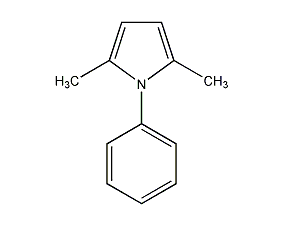
structural formula
| business number | 01tg |
|---|---|
| molecular formula | c12h13n |
| molecular weight | 171.24 |
| label |
1-phenyl-2,5-dimethylpyrrole, 2,5-dimethyl-1-phenyl-1h-pyrrole, 1-phenyl-2,5-dimethylpyrrole |
numbering system
cas number:83-24-9
mdl number:mfcd00022464
einecs number:201-461-2
rtecs number:none
brn number:124370
pubchem id:none
physical property data
1. physical property data
1. character: uncertain
2. density (g/ml,25/4℃): unsure
3. relative vapor density (g/ ml,air=1 ): unsure
4. melting point (ºc):50-51
5. boiling point (ºc,normal pressure):155-160
6. boiling point (ºc,5.2kpa): unsure
7. refractive index: uncertain
8. flash point (ºc): unsure
9. specific optical rotation (º): unsure
10. autoignition point or ignition temperature (ºc): unsure
11. vapor pressure (kpa,25ºc): unsure
12. saturation vapor pressure (kpa,60ºc): unsure
13. heat of combustion (kj/mol): unsure
14. critical temperature (ºc): unsure
15. critical pressure (kpa): unsure
16. oil and water (octanol/log value of the partition coefficient (water): uncertain
17. explosion limit ( %,v/v): unsure
18. lower explosion limit (%,v/v): unsure
19. solubility: uncertain.
toxicological data
none
ecological data
none
molecular structure data
5. molecular property data:
1. molar refractive index: 56.33
2. molar volume (m3/mol):177.7
3. isotonic specific volume (90.2k ): 427.1
4. surface tension (dyne/cm):33.3
5. polarizability(10-24cm3):22.33
compute chemical data
1. reference value for hydrophobic parameter calculation (xlogp): 3.1
2. number of hydrogen bond donors: 0
3. number of hydrogen bond acceptors: 0
4. number of rotatable chemical bonds: 1
5. number of tautomers: none
6. topological molecule polar surface area 4.9
7. number of heavy atoms: 13
8. surface charge: 0
9. complexity: 151
10. number of isotope atoms: 0
11. determine the number of atomic stereocenters: 0
12. uncertain number of atomic stereocenters: 0
13. determine the number of chemical bond stereocenters: 0
14. number of uncertain chemical bond stereocenters: 0
15. number of covalent bond units: 1
properties and stability
none
storage method
none
synthesis method
none
purpose
none
extended-reading:https://www.bdmaee.net/wp-content/uploads/2022/08/butyl-tin-triisooctoate-cas23850-94-4-butyltin-tris.pdfextended-reading:https://www.newtopchem.com/archives/668extended-reading:https://www.bdmaee.net/wp-content/uploads/2022/08/efficient-trimerization-catalyst-for-aliphatic-and-alicyclic-isocyanates.pdfextended-reading:https://www.bdmaee.net/dibutyl-tin-bis-1-thioglycerol/extended-reading:https://www.newtopchem.com/archives/44794extended-reading:https://www.bdmaee.net/dioctyl-tin-oxide-cas870-08-6-fascat-8201-catalyst/extended-reading:https://www.bdmaee.net/wp-content/uploads/2022/08/dibutyltin-monooctyl-maleate-cas25168-21-2-bt-58c.pdfextended-reading:https://www.newtopchem.com/archives/1875extended-reading:https://www.newtopchem.com/archives/814extended-reading:https://www.bdmaee.net/teda-catalyst-triethylene-diamine-/


